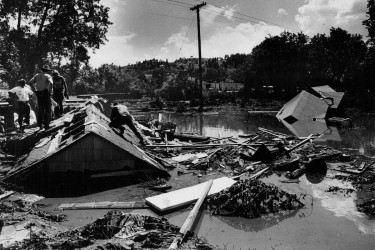Looking upstream, the Kinzua Dam seems to protrude brusquely from the Allegheny River. Nestled securely between the rolling hills of Warren County, Pennsylvania, the dam holds the river back. Behind it, the resulting Allegheny Reservoir stretches twenty-seven miles long and a hundred and twenty feet deep.
The Pittsburgh District of the United States Army Corps of Engineers completed construction of the Kinzua Dam in 1965 and manages it to this day. In 1936, Congress authorized the building of the dam as part of a system of reservoirs on the Monongahela and Allegheny rivers. According to Rose Reilly, a biologist with the Pittsburgh District of the Army Corps of Engineers, the Kinzua Dam has two congressional purposes: flood control and water quality improvement for the Pittsburgh region.
The formidable Kinzua Dam, which protects Pittsburgh from flooding and pollution, came at a steep price for the Seneca Nation of Indians. They lost nine communities and ten thousand acres of their Allegany Territory to the dam. Pressure from climate change, however, could threaten the protection gained from the Seneca Nation’s coerced sacrifice.
In 1956, plans for the Kinzua Dam — which for the previous two decades had been vague and nebulous — began to move forward. Twenty years earlier, in the infamous St. Patrick’s Day Flood, the entire Ohio River Basin had experienced catastrophic flooding. In Pittsburgh alone, water levels rose twenty-one feet above the usual flood level. In one day.
The devastation caused by the flood lent urgency to long-standing calls for a flood control project on the Allegheny River. Congress responded by passing the Flood Control Act of 1936, which paved the way for the eventual construction of the Kinzua Dam. Fervor for the project waned for many years as the United States became embroiled in military conflict. By the mid-1950s, Congress and the Army Corps of Engineers were ready to move forward. Dennis Bowen Sr., a Seneca survivor of Kinzua Dam, considers dam building an essential part of the federal government’s post-war strategy. “Keep in mind,” he says, “that, by the early 1950s, this was after World War II and the Korean War. There were a lot of white families that needed jobs, they needed industry, and those factories, those industries all across the country needed electric power. And so why not steal Indian land and build a dam and make hydroelectric power?”
In October 1956, against the Seneca Nation’s wishes, the Army Corps of Engineers began surveying Allegany Territory land in preparation for the Kinzua Dam. The proposed structure would require the flooding or condemnation of ten thousand acres of the Allegany Territory.













